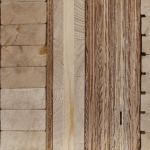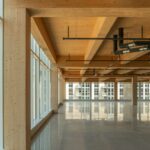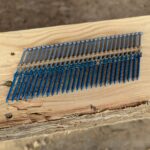Expert Tips
Adding Wood Structural Panels to Acoustically-Tested Assemblies
Information for building designers seeking to justify the inclusion of wood structural panels to tested assemblies, including placement, approaches and additional resources.

In many multi-family structures, interior demising walls that separate dwelling units from other units or from public spaces are required to have a minimum level of acoustical performance (IBC Section 1207). In some cases, these interior walls are also used as shear walls, utilizing plywood or OSB on one or both sides of the wall. Appropriate STC performance for walls are typically justified through the use of a tested assembly; however, most tested assemblies do not include wood structural panels (WSPs). This post contains information to help justify its inclusion in these cases.
In the WoodWorks technical paper, Acoustical Considerations for Mixed-Use Wood-Frame Buildings, author Steve Thorburn discusses the impact that WSPs can have on acoustical performance of walls. Adding shear wall sheathing to a wall assembly can actually increase its acoustical performance in certain circumstances because it adds mass to the assembly. As Thorburn notes, “In the past, using multiple layers of gypsum sheathing to increase the mass of the system has been the most common solution to raising the STC rating of the system.” He goes on, “In the case of shear wall sheathing, mass can be traded out for mass.” However, designers should be careful where they place WSPs within the wall assembly.
With respect to placement, two conditions that could negatively affect the STC performance of a wall are 1) if the WSPs impede the performance of resilient channels, and 2) if the WSPs alter the depth of the air cavity.
Resilient channels are a common component of many high-performing, acoustically-tested wall assemblies. If the assembly includes resilient channels on one side, the best practice is to put WSPs on the other (non-resilient channel) side of the wall, between the gypsum board and wall studs. Adding the panels directly beneath the resilient channels would create continuous contact points between the resilient channels and sheathing, counteracting the isolation purpose of the channels.

In the case of double wall assemblies, adding WSPs between walls reduces the depth of the air cavity and can create a trapped air space. Small air spaces between walls can become stiff, adding to the walls’ ability to couple together. Additionally, when sheathing is added between the walls, common resonance of the two thinner wall systems can be created. In this case, the walls radiate at the same frequency, coupling with each other, which reduces the wall system’s acoustical effectiveness. For these reasons, WSPs are better placed on the outer faces of the walls, maintaining the same depth of air space to better correspond with the tested assembly performance. Figure 6 of the WoodWorks acoustics paper illustrates the acoustical effect of sheathing placement in double wall assemblies.
When WSPs are necessary on two sides of a stud line, other options are available to avoid a reduction in STC performance:
- Utilize a tested wall assembly which does not include resilient channels.
- Alternatively, if using a wall that incorporates resilient channels, both layers of sheathing could be installed on the same side of the wall, between the studs and gypsum on the non-resilient channel side. APA’s TT 115 report lists criteria for how to properly construct such a condition as well as tested capacities. In lieu of a double layer of sheathing on the same side of the wall, a single layer of thicker sheathing could be used, and its capacity could be calculated. For more information on this option, see this previous WoodWorks Ask an Expert post.
The WoodWorks acoustics solutions paper linked above provides a summary of several acoustically tested wood frame wall assemblies. For further wood-frame wall assembly options, contact your local WoodWorks Regional Director or the WoodWorks Help Desk at help@woodworks.org.
Finally, from a fire performance perspective, this previous WoodWorks Ask an Expert post discusses the addition of a layer of WSP to a fire-tested wall assembly that didn’t include it.



